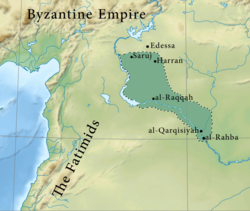
Back النميريون Arabic Numàyrides Catalan Numairiden German Dinastía Numáirida Spanish نمیری شاہی سلسلہ PNB Нумайриды Russian نمیری شاہی سلسلہ Urdu
Numayrid Emirate النميريون an-Numayriyyun | |||||||||||
|---|---|---|---|---|---|---|---|---|---|---|---|
| 990–1081 | |||||||||||
 The Numayrids at their zenith, ca. 1058–1060 | |||||||||||
| Capital | Harran | ||||||||||
| Common languages | Arabic | ||||||||||
| Religion | Shia Islam | ||||||||||
| Government | Emirate | ||||||||||
| Emir | |||||||||||
• 990–1019 | Waththāb ibn Sābiq al-Numayrī | ||||||||||
• 1019–1040 | Shabīb ibn Waththāb | ||||||||||
• 1040–1056 | Muṭaʿin ibn Waththāb | ||||||||||
• 1056–1063 | Manīʿ ibn Shabīb | ||||||||||
| History | |||||||||||
• Independence from Hamdanids | 990 | ||||||||||
• Loss of Edessa | 1031 | ||||||||||
• Fatimid vassalage | 1037 | ||||||||||
• Abbasid allegiance | 1060 | ||||||||||
• Uqaylids' conquest and later Seljuks | 1081 | ||||||||||
| Currency | Dirham, dinar | ||||||||||
| |||||||||||
| Today part of | Turkey Syria | ||||||||||
| Historical Arab states and dynasties |
|---|
 |
The Numayrids (Arabic: النميريون) were an Arab dynasty based in Diyar Mudar (western Upper Mesopotamia). They were emirs (princes) of their namesake tribe, the Banu Numayr. The senior branch of the dynasty, founded by Waththab ibn Sabiq in 990, ruled the Euphrates cities of Harran, Saruj and Raqqa more or less continuously until the late 11th century. In the early part of Waththab's reign (r. 990–1019), the Numayrids also controlled Edessa until the Byzantines conquered it in the early 1030s. In 1062, the Numayrids lost Raqqa to their distant kinsmen and erstwhile allies, the Mirdasids, while by 1081, their capital Harran and nearby Saruj were conquered by the Turkish Seljuks and their Arab Uqaylid allies. Numayrid emirs continued to hold isolated fortresses in Upper Mesopotamia, such as Qal'at an-Najm and Sinn Ibn Utayr near Samosata until the early 12th century, but nothing is heard of them after 1120.
As Bedouin (nomadic Arabs), most Numayrid emirs avoided settled life in the cities they controlled; rather, they ruled their emirates (principalities) from their tribal encampments in the countryside, while entrusting administration of the cities to their ghilmān (military slaves). An exception was Emir Mani' ibn Shabib (r. ca. 1044–1063), under whom the Numayrids reached their territorial peak. Mani' resided inside Harran, transforming its Sabian temple into an ornate, fortified palace. The Numayrids were Shia Muslims and initially recognized the religious sovereignty of the Sunni Muslim Abbasid Caliphate, at least nominally, but later switched allegiance to the Shia Fatimid Caliphate after the latter extended its influence into northern Syria in 1037. By 1060, they likely reverted to Abbasid suzerainty.